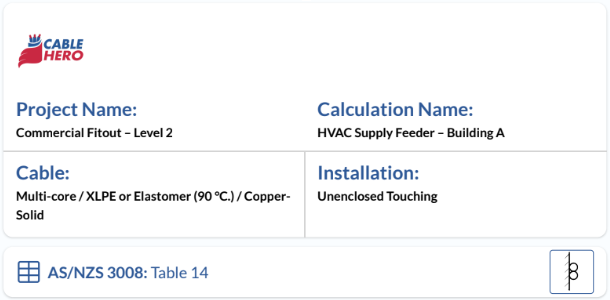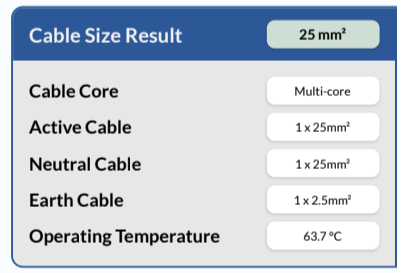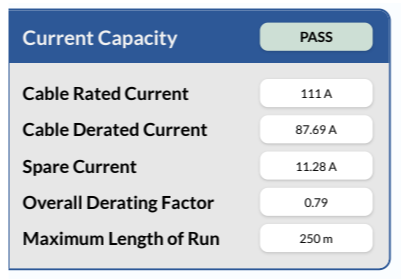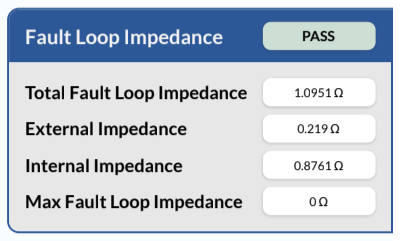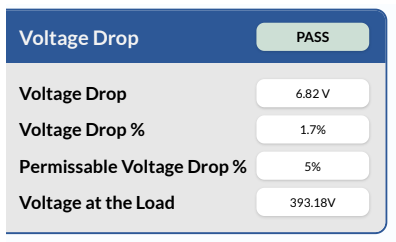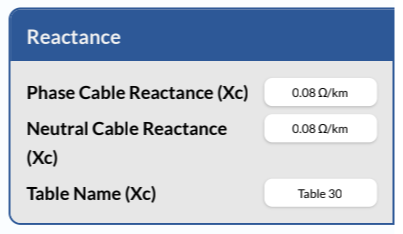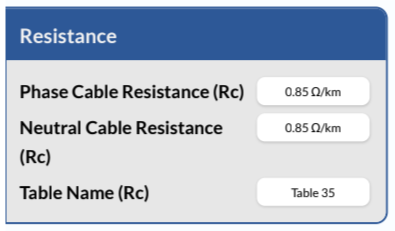Accurate and compliant electrical documentation has never been more important due to stricter safety standards and audits. Engineers and contractors should provide transparent, justifiable calculations during the certification and tendering stages for industrial projects. This reflects how accurate reports are important for winning approvals from authorities.
Fortunately, there are cable selection calculators that can make report documentation easier. Tools like CableHero have a PDF Export feature that makes it convenient to get accurate results from a user’s input. These make it easy to get instant calculations with no manual work needed. Here’s how these files support AS/NZS 3000 and AS/NZS 3008 compliance in projects.
Parts of a Cable Size Report
CableHero’s Cable Size Reports are structured to communicate technical accuracy, compliance, and project readiness. The reports from a cable selection calculator are divided into sections for easy interpretation. Below is a detailed breakdown of each section and its purpose:
Main Section
This section establishes the project’s identity. It includes the project name, calculation name, cable specifications, and installation method. This information forms the baseline for all analysis, ensuring that the report corresponds accurately with on-site conditions and aligns with AS/NZS 3008 installation standards.
Electrical Characteristics
This covers the electrical parameters under which the cable will operate. It includes load, voltage, supply type, power factor, fault level, and cable length. These characteristics form the calculations for cable sizing, voltage drop, and fault protection, which will be the technical basis of the design.
Cable Size Result
This section reports the details of the selected cable’s configuration. It covers the core count, active, earth, and neutral cable sizes, and operating temperature. These elements reflect sizing outcomes based on safety and regulatory criteria under AS/NZS 3008 rules. These results also impact the grouping of cables and conduits.
Current Capacity
The current capacity analyses how much current the cable can carry. It factors the rated and derated value, ensuring the cable’s capacity aligns within the limit for safe operation. In addition, the spare capacity, overall derating factor, and the cable’s maximum permissible length are displayed to ensure that the voltage and safety limits are implemented.
Fault Loop Impedance
The Fault Loop Impedance section evaluates the total impedance of the fault path, breaking it into external and internal components. It also verifies if the selected cable meets the maximum allowable impedance thresholds for circuit protection under Australian Wiring Rules.
Voltage Drop
This section tracks and calculates the voltage drop along the cable run and compares it with the 5% standard limit. You can also customise your own permissible voltage drop. In addition, it states how much voltage is received at the load end, ensuring delivery remains efficient and within regulation.
Short Circuit Performance
The short circuit performance focuses on fault scenarios, wherein the section presents the minimum conductor sizes and expected short-circuit currents. It also ensures the cable system can endure fault energy without causing thermal damage and allows devices to disconnect safely and within time.
Reactance
This section presents the values of phase and neutral cables, as referenced from standard tables. This information is important to accurately model inductive effects in long cable runs or three-phase systems, which impact voltage and fault calculations.
Resistance
This section details the cable resistance of phase and neutral conductors, which will affect voltage drop, fault current, and energy losses. It also includes source references for data accuracy, aiding design transparency.
The Derating Factor Breakdown
The derating factor outlines how environmental conditions, such as cable arrangement and ambient temperature, reduce the cable’s current capacity. A cable selection calculator automatically applies adjustments, ensuring that the final cable size recommendation is both safe and compliant in installation environments.
Protection
This section defines the circuit’s overcurrent protection device. It specifies the type (MCB, MCCB, or manual), rating, and tripping characteristics needed for proper fault-clearing performance. This configuration ensures the selected breaker matches the cable’s thermal capacity according to the AS/NZS standards for safety and operation. In the provided sample, protection is marked as “Not Enabled” because no protective device parameters were entered.
How to Use Cable Size Reports for Approvals
Because of their technical clarity and support, cable size reports can present verified electrical data in a clear, standards-compliant format. Here are the steps to make the most of these reports in your workflow:
Step 1: Generate the Report
Start by using a cable selection calculator to input design parameters such as voltage, load, installation method, cable specifications, and fault level. After completing the calculation, export the detailed PDF report for certification or tendering.
Step 2: Attach File for Submission
Include the PDF file along with single-line diagrams, protection schedules, and technical datasheets. This gives certifiers a clear breakdown of all parameters, such as fault loop impedance and voltage drop compliance.
Step 3: Highlight Key Specifications
When submitting proposals, reference calculated spare current capacity, derating factors, and short-circuit withstand values. These specifications show rigour and readiness, giving any project a technical edge.
Get Cable Size Reports at CableHero
A trusted cable selection calculator delivers a full range of validated electrical data in a format trusted by certifiers, engineers, and contractors. Every detail, from installation method to current capacity, is rooted in AS/NZS 3000 and AS/NZS 3008 compliance, ensuring designs pass scrutiny and perform reliably in actual conditions.
Whether preparing a project bid or finalising a compliance pack, doing a cable report can be tedious when done manually. Fortunately, CableHero’s online calculators have PDF export features that help you move quickly and precisely. To generate a cable size report, sign up for a free account today!
Frequently Asked Questions (FAQs)
Whether you’re validating your project for compliance or preparing for certification, here are some things you need to know when reviewing cable reports using CableHero:
How to confirm the voltage drop?
To confirm voltage drop, compare the calculated value against the maximum allowable percentage stated in AS/NZS 3000 Clause 3.6.1. According to standards, only 5% of final subcircuits are allowed. To ensure accurate calculations, you can use a reliable cable calculator, which automatically calculates voltage drop based on load current, conductor size, length, and installation conditions.
What is a good loop impedance reading?
A good loop impedance reading ensures that fault currents are high enough to trip overcurrent devices within the required disconnection time. This is in reference to AS/NZS 3000 Clause 2.5.4, which outlines the maximum values based on the protective device rating and circuit type.

